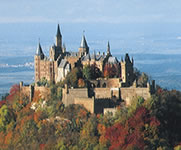Other highlights
Suggested excursions
Days out in Rheinhessen promise excitement and surprises round every corner. Experience a warm welcome in bustling wine villages, marvel at impressive monuments and romantic castles, and explore a landscape shaped by the hand of man. Although the Rhine is known mainly as a German river, it also happens to be one of Europe's major waterways. Along its course is the cathedral town of Worms, known for its Luther associations and shrouded in the legends of the Nibelungs. The Palatinate Forest meanwhile, has earned a place in the UNESCO Network of Biospheres due to its well-preserved ecosystem. The Rhine
Following the 1,320-km course of the Rhine from its source in Switzerland to the river's mouth in the North Sea, the most interesting section is without doubt the Middle Rhine and the stunning Rhine Valley between Mainz and Bonn. It is Germany's number one river and the most important waterway in Europe. Throughout history, countless famous eyes have looked upon and admired the Rhine. Now, millions of tourists from all over the world do the same, year after year. Since Roman times the Rhine Valley has been the scene of pivotal events in western history, and the land is wrapped up in myths and legends such as the Loreley or the Nibelung's treasure. A river cruise is the best way to discover what is considered the most beautiful stretch of the Rhine with its abundance of castles. Worms
Boasting a number of sights of historical importance, Worms is one of the oldest towns in Germany. Situated in the heart of the wine-growing region between Mainz and Speyer, it is famous for its associations with the reformer Martin Luther and for the Cathedral of St. Peter, which dates back to late Roman times. 1,000 years of the town's Jewish community can be explored in the Raschi House, while Heiliger Sand is Europe's oldest Jewish cemetery. Today, the town of Worms is inextricably linked with the legend of the Nibelungs. Palatinate Forest nature reserve
This densely wooded nature reserve in the south of Rhineland-Palatinate covers a total area of around 180,000 hectares. It is the largest unbroken area of forest in Germany, as well as the country's most varied and impressive sandstone landscape. The nature reserve encompasses the central, northern and southern Palatinate Forest as well as the German Wine Route, a former conservation area. Lined with chestnut-tree woodland on either side, the route is ideal for exploring this beautiful scenery with its gorges, vineyard terraces and fruit and almond trees. The picture is completed by quaint historical villages, where local wine-growing traditions are alive and well.
Following the 1,320-km course of the Rhine from its source in Switzerland to the river's mouth in the North Sea, the most interesting section is without doubt the Middle Rhine and the stunning Rhine Valley between Mainz and Bonn. It is Germany's number one river and the most important waterway in Europe. Throughout history, countless famous eyes have looked upon and admired the Rhine. Now, millions of tourists from all over the world do the same, year after year. Since Roman times the Rhine Valley has been the scene of pivotal events in western history, and the land is wrapped up in myths and legends such as the Loreley or the Nibelung's treasure. A river cruise is the best way to discover what is considered the most beautiful stretch of the Rhine with its abundance of castles.
Boasting a number of sights of historical importance, Worms is one of the oldest towns in Germany. Situated in the heart of the wine-growing region between Mainz and Speyer, it is famous for its associations with the reformer Martin Luther and for the Cathedral of St. Peter, which dates back to late Roman times. 1,000 years of the town's Jewish community can be explored in the Raschi House, while Heiliger Sand is Europe's oldest Jewish cemetery. Today, the town of Worms is inextricably linked with the legend of the Nibelungs.
This densely wooded nature reserve in the south of Rhineland-Palatinate covers a total area of around 180,000 hectares. It is the largest unbroken area of forest in Germany, as well as the country's most varied and impressive sandstone landscape. The nature reserve encompasses the central, northern and southern Palatinate Forest as well as the German Wine Route, a former conservation area. Lined with chestnut-tree woodland on either side, the route is ideal for exploring this beautiful scenery with its gorges, vineyard terraces and fruit and almond trees. The picture is completed by quaint historical villages, where local wine-growing traditions are alive and well.
Travel Planner
Select an option...



